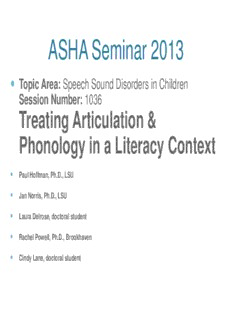
Treating Articulation & Phonology in a Literacy Context - yimg.com PDF
Preview Treating Articulation & Phonology in a Literacy Context - yimg.com
ASHA Seminar 2013 Topic Area: Speech Sound Disorders in Children Session Number: 1036 Treating Articulation & Phonology in a Literacy Context Paul Hoffman, Ph.D., LSU Jan Norris, Ph.D., LSU Laura Delrose, doctoral student Rachel Powell, Ph.D., Brookhaven Cindy Lane, doctoral student Scaffolded Writing Using a Cloze Spelling Procedure for Developmentally Disabled Students Laura Delrose, M.A., CCC-SLP Doctoral Student Louisiana State University Why DD? NCLB (2001) and IDEA (2004) changed the way that students with severe disabilities participate in the curriculum and high-stakes assessments. IEP were goals not aligned with curriculum and focused on functional living skills. Most instruction focused on sight word learning. No impact on comprehension/functional use Does not lead to reading or writing skills National Reading Panel (NRP, 2000) identified the essential components of learning to read for ALL students Vocabulary, fluency, comprehension, phonemic awareness, and phonics Still a lack of phonemic awareness and phonics instruction and research for this population. Research and instruction on writing and spelling development also lacking for students with significant disabilities. Connections Oral language, reading, writing, spelling Spoken and written language share some features including: Phonology Pragmatics Semantics Syntax Morphology Speech & Spelling Spelling is developmental and follows a predictable sequence. Spelling shares the same developmental principles and phonological process errors as speech. Confirmed by study conducted by Read in 1975 Consistent patterns of invented spellings across children for same words Demonstrated awareness of features of sounds and speech production Not just memorization Gentry’s Stages of Spelling 1. Precommunicative 5 substages 1a. Early scribbling 1b. Prewriting experimentation Attempts at imitating writing Meaning changes, no permanent message Beginnings of content, form, function Precommunicative Substages 1c. Pre-phonemic Alphabet, numbers, lines, No letter-sound correspondence Upper- and lower-case letters No left to right orientation Precommunicative Substages 1d. Early phonemic Initial letters follow alphabetic principle Random letters may follow some may follow sounds or shape of word 1e. Letter name One letter may represent a syllable I like dinosaurs. DS = dinosaurs Stages of Spelling Cont’d 2. Semi-phonetic Incomplete syllabic/phonemic representation Phonological processes seen in speech Final consonant deletion, stopping, devoicing, cluster reduction, etc Students in this study are functioning in the substages of the precommunicative stage and the semi-phonetic stage.
Description: